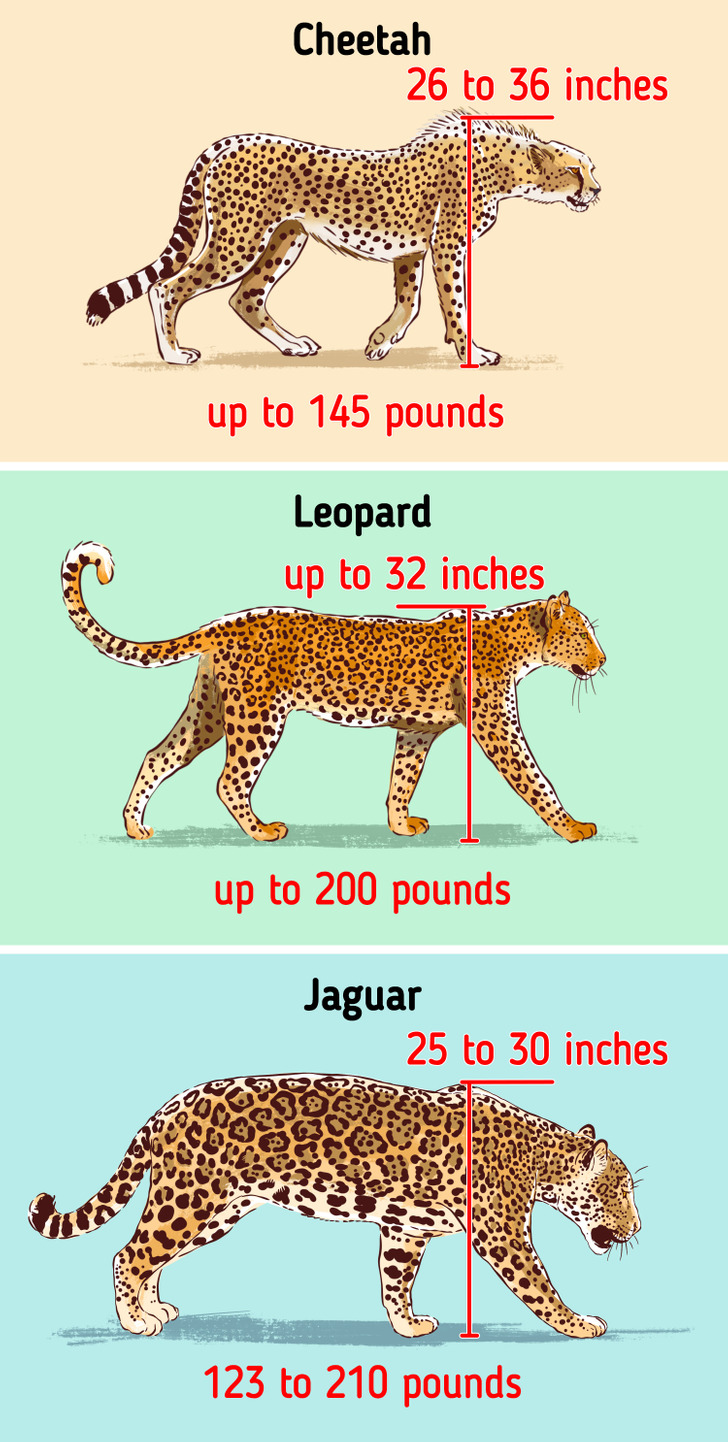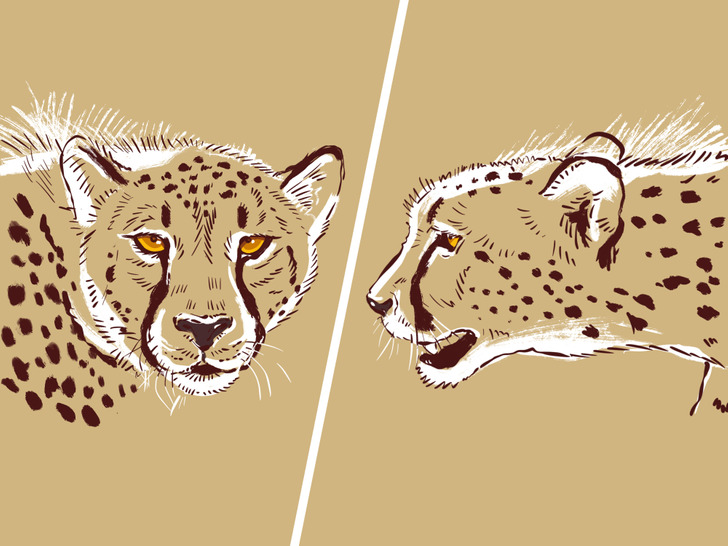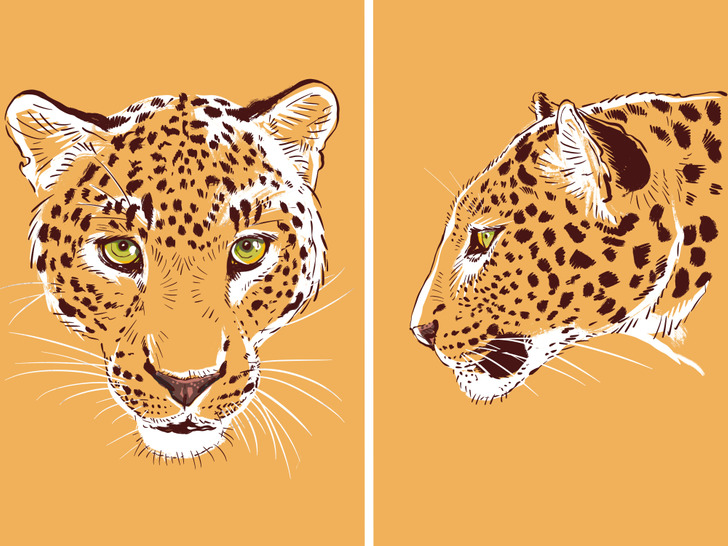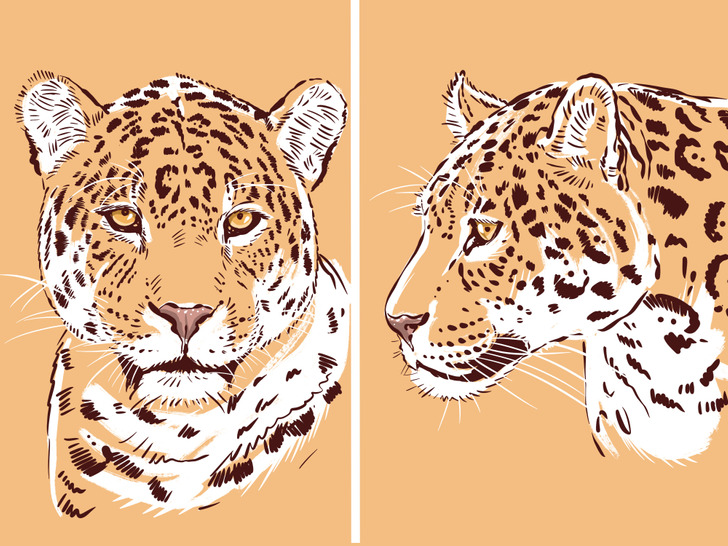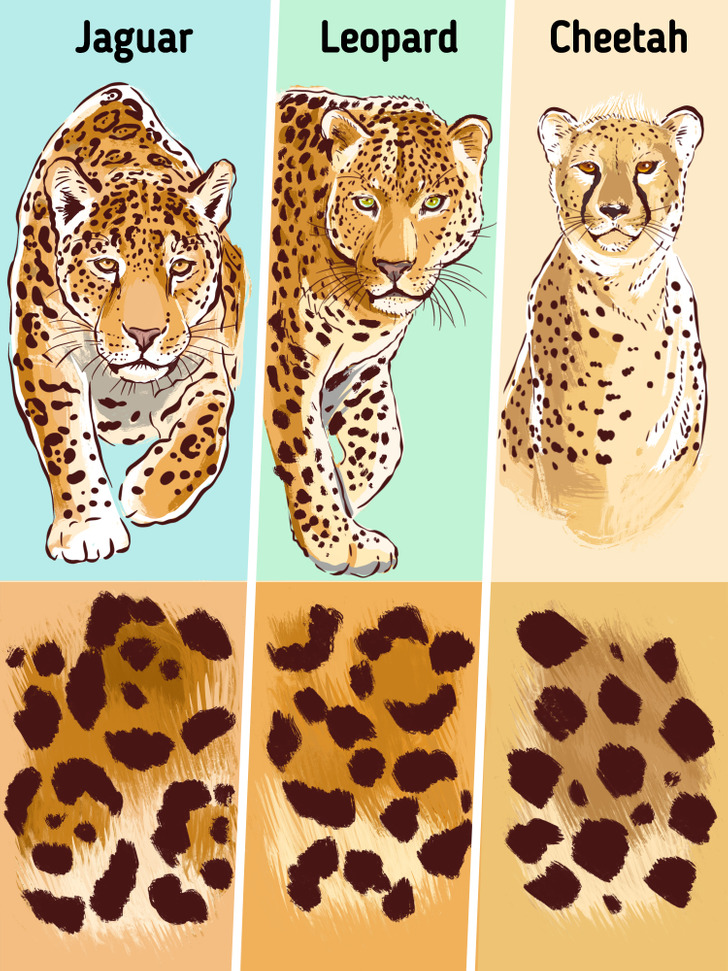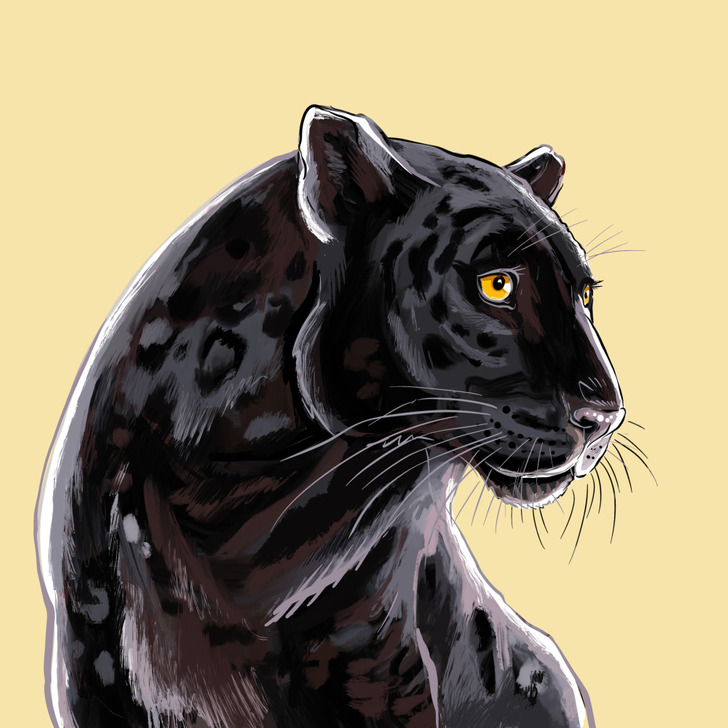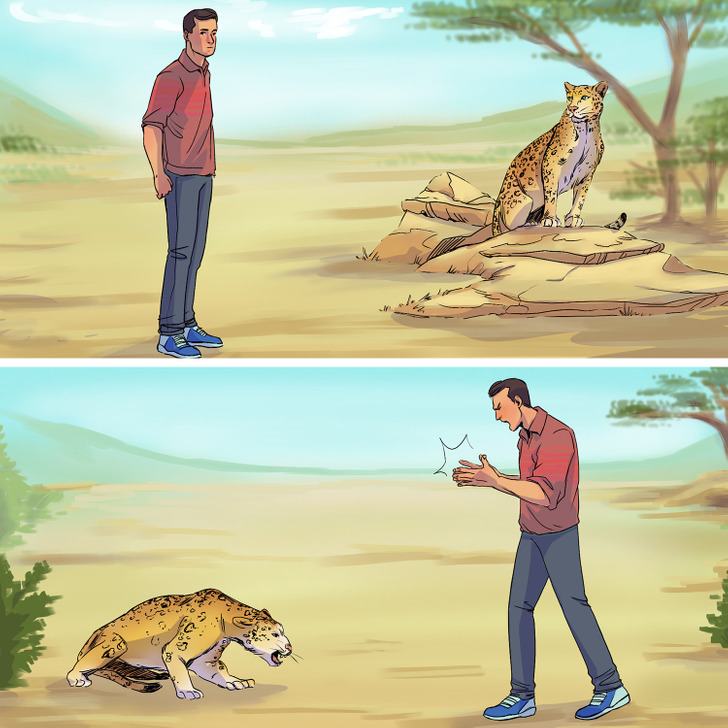If you don’t know how to tell a cheetah from a leopard, or a leopard from a jaguar, you are not alone. These large spotted cats are often confused with each other, but the truth is that there are more differences between them, than similarities. Due to their unique and colorful appearance, jaguars, leopards and the cheetah are some of the most loved and popular animals worldwide. Shows like Tiger King are only clear proof that wild cats, including leopards and jaguars, are very much sought after.
Cheetah, leopard, and jaguar are three types of large cats that belong to the family Felidae. They are superficially similar but there are some major differences in behavior and physicality. The only reason these three creatures are being compared to one another is probably due to their size, since they are much smaller than lions to be compared to them. This article will help you understand the difference between a cheetah, a jaguar and a leopard in the most simple way.
The size, weight, and body shape of a cheetah, a leopard and a jaguar
- Compared to the leopard and the jaguar, the cheetah has a rangy greyhound-like thinner body frame and a small head. It has longer, thinner legs and a long, agile tail that helps it move easily in pursuit of prey. Cheetahs are pretty tall and light. The average height of a cheetah is 26 to 36 inches, and the weight usually doesn’t exceed 145 pounds, but there are also larger individuals, whose weight can reach 160 pounds.
- The leopard has relatively short legs and a long body with a large skull, especially when compared to the cheetah. The leopard has a lighter build than the jaguar, but more muscular than the cheetah. The weight of leopards can reach 200 pounds, and their height can reach 32 inches.
- The jaguar is one of the largest cats in the world. Only tigers and lions are bigger, stronger, and more massive. This animal has a very strong body, but it’s not as flexible and mobile as a leopard, and not as rangy as a cheetah. The jaguar can weigh up to 350 pounds (although the average weight is anywhere from 123 to 210 pounds), the height is usually 25 to 30 inches.
Head characteristics
- The cheetah has a small rounded head and a short snout. Cheetah’s eyes are amber-brown, they are set high, and they have round pupils. Its jaws are not very massive, and its whiskers are quite short. The cheetah has “tear marks” — they are the black lines that run from the inside corner of its eyes down its cheeks. Rapid acceleration requires a cheetah to have high oxygen intake adaptations including enlarged nostrils and extensive, air-filled sinuses. While running, a cheetah’s specially adapted repertory system allows it to go from a normal rate of 60 breaths per minute to 150 breaths per minute.
- The leopard’s head is much larger and more elongated than that of the cheetah, with powerful jaws. The whiskers are well developed (this difference is especially striking when compared with the cheetah’s whiskers), the eyes are yellow-green (apart from the Amur leopard of the Russian Far East that has blue eyes).
- The jaguar has a large head and powerful jaws just like the leopard. But its face is fat and rounded. Besides, it has a much broader forehead and a wider jaw.
Coat differences
Despite the fact that the cheetah, the leopard, and the jaguar have a spotted coat, they are not identical.
- “Rosettes” on jaguars can be bigger and not that circular, unlike those of leopards. They may include one or several dots. Most rosettes have a black spot in the center, separated from the outer ring by the animal’s yellow ground color. Spots found on the head and neck are generally solid, as are those on the tail.
- The leopard’s spots also resemble “rosettes.” But they are smaller and more round than those of the jaguar. Overall, the fur under the belly tends to be lighter in color and of a softer, more downy texture. Solid black spots in place of open rosettes are generally seen along the face, limbs, and underbelly.
- Cheetahs have solid, round, polka-dot type black spots measuring 0.79 to 1.2 inches across. There are no spots on their white underside, but the tail, which usually ends in a bushy white tuft, does have spots that merge to form 4 to 6 dark rings at the end. Cheetahs have an upper coat of fur that is tawny, pale buff or grayish white, with underparts that are paler and whiter. Black spots are set close together on the pelage with a series of black rings around the last one-third of the tail. Black tear markings under the eyes are thought to protect against the sun’s glare and to help focus better attention on prey. Cheetah kittens have fur colored in a way that is opposite normal countershading, in theory to mimic the coloration of a honey badger.
A few other curious facts
- A black panther is the melanistic color variant of the leopard and the jaguar. There is no such species as a “black panther,” it’s just a leopard or jaguar with excess melanin.
- The leopard and the jaguar belong to the same genus, Panthera, and can be considered close relatives. The cheetah belongs to a different genus, Acinonyx, and is not a “big cat.”
The leopard and the jaguar who belong to big cats can only roar but cannot purr. Cheetahs, on the other hand, can only purr. The structure of the cheetah’s voice box doesn’t allow it to roar.
The jaguar’s huge jaw muscles and teeth give it the strongest bite force of any mammal, allowing it to pierce the armor of a caiman and a tortoise.
- Cheetahs are more social than leopards and jaguars. They are able to join in groups and take care of each other. The leopard and the jaguar are solitary animals. They form pairs only during the breeding season.
- The cheetah is the only cursorial hunter in the cat family. Unlike the majority of other big cats who are ambush predators, its hunting strategy is based on its ability to sustain a high-speed chase across the open savannah. This incredible cat is capable of reaching a speed of 75 miles per hour and taking sudden sharp turns at high speed.
- Leopards are excellent tree climbers thanks to their long feline tails which aid their balance when in trees. A leopard’s power is such that it can carry a victim who is up to 3 times its own weight up a tree. In fact, it is the only big cat known to carry dead prey up into a tree. Jaguars are also quite agile in trees. Cheetahs are often seen sitting on the lower branches of trees where they reach by jumping off the ground.
- Cheetahs hunt during the day while leopards and jaguars prefer to hunt at night.
- Jaguars thrive in and around water, regularly hunting caiman and anacondas, and even diving for large fish. Leopards can swim, but prefer to hunt on land, just like cheetahs.
Other facts about leopards, cheetahs and jaguars
- Leopards have extraordinary eyesight, something that helps them a lot when it comes to catching their prey.
- Leopards can give birth at any time during the year, but their peak season is the dairy days of the year.
- One massive difference between cheetahs and leopards, is that the first are faster than the second. That’s because a cheetah has longer and slender legs, while a leopard has shorter legs.
- Jaguars have a stronger and more lethal bite than a leopard. Their teeth are stonger and they only need a few seconds to crash their opponent’s bones. Their entire body is a lot more muscular. This is another difference between jaguars and a leopard.
- There are around 173,000 jaguars left in the world today, and most of these big cats are found in the Amazon rainforest and the Pantanal, the largest tropical wetland. Their stronghold is in Brazil — it may hold around half of the estimated wild numbers.
- Male jaguars can weigh 120kg (that’s almost 19 stone), while female jaguars can weigh much less, up to 100kg. But their sizes can vary a lot between regions — jaguars in central America can be roughly half the size of jaguars in the Pantanal. They need that bulk behind them to take on big prey, including giant caiman.
- Leopards are fast felines and can run at up to 58km/h! They’re super springy, too, and can leap 6m forward through the air — that’s the length of three adults lying head to toe.
- Nocturnal animals, leopards are active at night when they venture out in search for food. They mostly spend their days resting, camouflaged in the trees or hiding in caves.
- A cheetah chase usually lasts less than a minute, and covers just 200-300 metres. At full speed, the cheetah takes three strides a second, covering seven metres per stride — it’s not surprising they tire quickly, and conserve energy for much of the time. One study found that cheetahs spent only 12% of their day moving around.
Bonus: How to protect yourself from leopards in case they try to attack you
By all means, don’t approach a leopard. And especially not leopard cubs. A mother leopard is very defensive, and she will most likely attack you in order to protect them.
- If you see one, stand still and don’t make eye contact.
- If the leopard is preparing to attack you, shout, wave your arms, clap your hands, and anything else that will help you appear menacing.
According to someone who experienced an attack from leopards “When my children were young, a large male leopard lurked around our camp for about a week. Each evening, his presence was advertised by the alarm calls of nearby bushbucks and pukus, though I only saw him a few times. Then, one night, the leopard attacked an old man. Though his injuries weren’t serious, the man died the same day.”
Bonus 2: How to protect yourself from jaguars in case they try to attack you
- Jaguars are ambush hunters- assuming it was an ambush- the only chance would be if the animal was startled by someone or something interfering and the cat runs off. If a jaguar hit you from any angle, the force of that hit would shatter every nerve in your body, you wouldn’t be able to think let alone react! He knows what to do next and wouldn’t be affected by anything you could do.
Shannon Phelps / Quora - My first encounter with a jaguar happened at night and the darkness, we know, is the mother of all fears. I confess that I was apprehensive, exhaling fear in the air, which can be fatal, because I learned from dealing with bulls that when we show our fear, animals can easily understand and that gives them the courage to charge us. Fear looks like a star shining in the darkness, and when animals attack, they are deadly, no matter how strong we are. Another meeting happened in the afternoon and I was able to contemplate all the beauty of the animal, until it disappeared as if by magic. Although the man is not on his menu, a jaguar will kill him with just one bite if he feels cornered. In fact, any cornered animal can kill. It is the time of greatest danger, because adrenaline leads to panic and jaguars will attack with all fury and then it will run away without looking back. Rogerio Rufino / Quora
Bonus 3: How to protect yourself from a cheetah in case they try to attack you
- If you are literally being attacked by a cheetah, by far the most likely and possibly only reason that is taking place is because you have given the cheetah reason to believe that you are a threat to her youngsters. If that is the case, there is no one that can give you any advice other than the standard advice for what to do if actually being engaged in battle with any of the Big Cats or semi-Big Cats, like the cougar, for instance. There is no strategy at that point. You will be on the receiving end of anger, teeth and claws. You’re not going to have a lot of time or clarity of mind to devise a strategy. You can’t play dead. Stefan Pociask / Quora
- So if the cheetah wanted to attack me I couldn’t outrun it so I would probably try to hide. If hiding didn’t work because we are in the savanna then I would try to outsmart the cheetah because if I could hide, the cheetah would most likely be able to get there too. Abi Baker / Quora
Now that you’ve read this article, would you be able to notice the difference between a leopard, a jaguar and a cheetah if you were to see them out in the wild? And if you did see one of them, what would your first reaction be?

